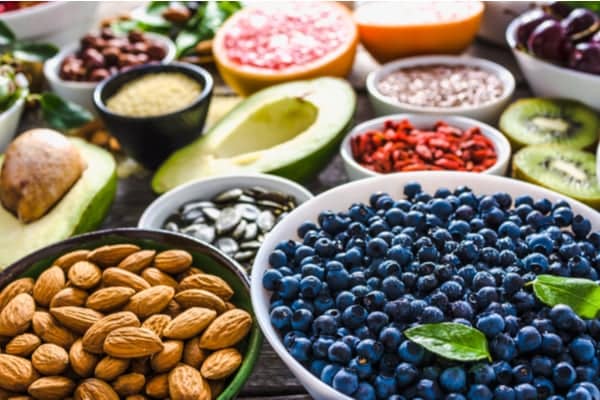You know that maintaining a healthy, well-balanced diet is crucial to reaching and managing your health and fitness goals. But how do you know what type of diet and foods are the best to help you meet your goals? One of the growing trends in nutrition is the raw foods diet. If you’re considering seeing how you can benefit from raw foods, there are some important things to know before you take the plunge.
Raw Foods 101
A raw foods diet is quite literally consuming food in its most natural or raw form. Living in a world pre-packaged, processed food means that your options are limited, but food in its raw state is fresh, cleansing, and offers unique benefits. Some of the main sources of nutrition in a raw foods diet include:
- Fresh and dried fruit
- Fresh vegetables
- Seeds and seed butters
- Nuts, nut-based “milk,” and nut butters
- Sprouted grains
- Cold-pressed oils
- Fermented food (e.g., kimchi, sauerkraut)
Although it might seem like a raw foods diet is really just a vegan diet, the truth is that some raw foods communities also consume meat (raw and dried), fish, dairy, and unpasteurized eggs. How? Because raw foods diets are all about the temperature of the food. On a raw foods diet, food can’t be cooked to or consumed at more than 118°F (48°C).
So, on a vegan diet, you’ll probably enjoy Skillet Baked Oatmeal with Summer Stone Fruit, but on a raw foods diet you’d be more likely to whip up Banana Mocha Overnight Oats. Additionally, there are those who follow the dictum that a raw foods diet consists of at least 75 percent raw foods, but the rest can be whatever you choose. Others follow the raw foods diet at 100 percent raw, 100 percent of the time.
The Pros and Cons
Like anything in the health and wellness world, there are people on both sides of the raw foods diet debate. Ultimately, you need to consider your specific situation and decide whether the raw foods diet is right for you. Here is a quick look at some of the pros and cons of the raw foods diet.
Raw Foods Diet Pros
- Consuming raw foods preserves vital nutrients that are lost in cooking, especially water-soluble vitamins such as Vitamin C and Vitamin B.
- Raw foods diets are generally low calorie, which can lead to weight loss and decreased body fat.
- A raw foods diet limits the consumption of sugar-filled processed foods that contribute to countless chronic diseases such as diabetes and heart disease.
- Raw foods deliver something most people are missing a lot of: fiber. Fiber helps you feel fuller longer, so a raw foods diet can aid in making healthier eating choices.
- Above and beyond the benefits to individual health, a raw foods diet is also better for the environment, saves energy, and raw foodies leave a smaller carbon footprint.
Raw Foods Diet Cons
- Our bodies struggle to break down highly fibrous plant material, and cooking helps make food more digestible, which allows the body to more easily receive vital nutrients and calories.
- Consuming raw or undercooked meat, fish, or eggs can cause illness because harmful bacteria are not killed during the cooking process.
- Some nutrients and antioxidants such as lycopene and beta-carotene actually increase during the cooking process.
- Consuming high-phytate foods, including nuts, grains, and legumes, in their raw form can increase the likelihood of an iron or zinc deficiency.
- Raw foods are often nutritionally unbalanced, which means you’re usually consuming loads of fats or fruits to meet daily caloric requirements. This can result in unbalanced or deficient levels of vitamins, minerals, and protein.
How to Get Started
The first thing you’ll have to do when launching a raw foods diet is empty your kitchen. As you purge your kitchen, consider how much of the food in your fridge, freezer, and pantry doesn’t fall under the “raw foods” category—it will probably shock you.
Invest in Gadgets
Next up, make sure you have the practical tools to get the most out of a raw foods diet. Blending, juicing, sprouting, dehydrating, and soaking are all popular ways to maximize the possibilities of raw foods, so be sure to invest in some kitchen equipment to give you plenty of options. Here are some suggestions for kitchen gadgets to have in your raw foods kitchen:
- Graters and peelers
- Blender
- Food processor
- Spiralizer (for making zoodles!)
- Juicer
- Dehydrator
- Mandolin/slicer
- Spice grinder
Know What to Avoid
Although there is a lot that you can eat on a raw foods diet, it’s important to know what you should be avoiding. Here are some of the common foods you’re probably used to eating that you’ll need to start avoiding:
- Food cooked above 118°F (48°C)
- Roasted seeds
- Roasted nuts
- Refined sugars, oils, and flours
- Pasteurized juices
- Pasteurized dairy products
- Tea and coffee
- Alcohol
- All processed foods (e.g., chips, pasta, pastries)
Plan Meals to Avoid Cravings
By its nature, the raw foods diet is low-calorie. At the same time, raw foods are chock-full of fiber, so you should stay fuller longer. Either way, to avoid hunger attacks and ensure you’re maintaining a balanced diet throughout the day, plan ahead and make sure you have plenty of snacks and nutritious, filling main courses lined up. Here is an example of a day eating raw food:
- Breakfast: Raw Almond Butter Overnight Oats
- Snack: Almond butter and banana
- Lunch: Superfood Crunch Salad with Homemade Balsamic Apple Vinaigrette
- Snack: Sliced apples with almond butter
- Dinner: Raw Peanut Zoodle Salad
- Dessert: Carrot Cake Bites
Work with a Health and Wellness Professional
If you’re feeling overwhelmed by the details and don’t even know where to begin, consider working with a health and wellness professional. A trained nutrition consultant can provide a personalized assessment and meal plan in order to guarantee that you’re getting enough of the right vitamins, minerals, and nutrients.
And maybe, just maybe, that health and wellness professional is you! Whether you’re interested in a raw foods diet for yourself or a friend has been talking your ear off about taking the raw foods plunge but isn’t sure where to start, our 8 Step Guide to Becoming a Nutrition & Wellness Consultant could be what you need to turn your passion for healthy living into a career.

Unleash the Power of Nutrition Science to Revolutionize Overall Health and Wellness
Download your free guide now.



